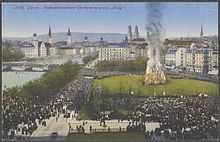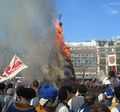Sechseläuten
| Sechseläuten | |
|---|---|
|
Böögg in 2012 | |
| Observed by | Canton of Zurich, Switzerland |
| Date | third Monday in April (with exceptions) |
| 2014 date | 28 April |
| 2015 date | 13 April |
| 2016 date | 18 April |
| 2017 date | 24 April |
| Frequency | annual |
The Sechseläuten (Zürich German: Sächsilüüte) is a traditional spring holiday in the Swiss city of Zürich celebrated in its current form, usually on the 3rd Monday of April, since the early 20th century.
Burning of the Böögg
Following the parade of the Zünfte (guilds), the climax of the holiday is the burning of Winter in effigy, in the form of the Böögg, a figure of a snowman prepared with explosives. The custom of burning a rag doll called Böögg predates the Sechseläuten. A Böögg (cognate to bogey) was originally a masked character doing mischief and frightening children during the carnival season.
History

The roots of the festival go back to medieval times when the first day of summer working hours was celebrated in the guildhalls across the city. City ordinances strictly regulated the length of the working day in that era. During the winter semester the workday in all workshops lasted as long as there was daylight, but during the summer semester (i.e. starting on Monday following vernal equinox) the law proclaimed that work must cease when the church bells tolled at six o'clock. Sechseläuten is a Swiss German word that literally translates into "The six o'clock ringing of the bells". Changing to summer working hours traditionally was a joyous occasion because it marked the beginning of the season where people had some non-working daylight hours.
Burnings of Böögg figures (the Swiss German term for "bogey", in origin scary-looking ragdolls) in spring are attested in various places of the city from the late 18th and early 19th century, without direct connection to the Sechseläuten. The combination of the Sechseläuten parade and the burning of an official Böögg was introduced in 1902.
From 1902 until 1951, the holiday used to be held on the first Monday following vernal equinox. On that day, the Fraumünster bell, for the first time in the year, tolled to mark the end of working hours at 6 p.m. (historically the time of sunset on vernal equinox). The holiday was moved to the third Monday of April in 1952. Because of the later date, and because of summer time introduced in 1981, the lighting of the Böögg's pyre at 6 p.m. has now moved to several hours before nightfall. Additionally, because of its present date, the holiday is often within a week of 1 May, leading to a stark contrast between the upper class dominated Sechseläuten and the working class holiday of May Day. This proximity of the major festivals of two political poles of the society of Zürich has led to various interferences in the past, for example the abduction of the Böögg in 2006 by leftist "revolutionaries" a few days before the Sechseläuten. Since then, several Bööggs are held in reserve with the main one stored at a bank nearby the Sechseläutenplatz (the open area in front of the Opernhaus near Bellevue where most Zürich open air activities take place). Since 2010 the guilds of Zürich allow the women of Gesellschaft zu Fraumünster to practice Sechseläuten, usually just being guests of the guilds respectively the Constaffel society, but still not being as an official guild in Zürich.
Weather oracle
Popular tradition has it that the time between the lighting of the pyre and the explosion of the Böögg`s head is indicative of the coming summer: a quick explosion promises a warm, sunny summer, a drawn-out burning a cold and rainy one. The shortest time on record is 5:07 minutes in 1974 and the longest is 40 minutes in 1970 and 1988.[1] The 2007 explosion of the Böögg`s head (on 16 April 2007) took place 12:09 minutes after the pyre was lit, promising a medium warm summer. On 14 April 2008, heavy rains soaked the Böögg and the wood pyre materials so much that "firemen" in the style of Fahrenheit 451 had to spray the pyre with kerosene or fuel oil after initial ignition in addition to 15 liters of fire accelerant which was initially thrown on the pyre. It took 26:01 minutes for the Bööggs head to explode which indicates a poor weather summer.
Sechseläuten in recent years
The Sechseläuten of 2008 took place on 14 April. Officially, the head exploded only after 26 minutes and one second, promising a rather poor summer. The fact that the head, instead of traditionally exploding, burnt down very quietly caused a lot of confusion. After approximately 20 minutes the head had burnt away completely, but leaving a large piece of the neck hanging from the stake. It was the explosion of that piece that ended this year's event.
In 2012 it took 12 minutes and 07 seconds, and in this year there was some confusion if both firecrackers in the neck of the Böögg had exploded. It was determined that 12 min 07 secs was the mark.
Additional events
Additional events of the holiday nowadays also include:
- A 'Kinderumzug' (children's parade) in historic and folkloristic costumes on the Sunday preceding the Sechseläuten.
- A very colorful afternoon parade of the 26 guilds in their historic dress costumes, each with its own band, most with a sizable mounted 'Reitergruppe', and horse drawn floats, to the 'Sechseläutenplatz' at the lakeshore where the Böögg is burnt.
- A ceremonial galloping of the mounted units of the guilds around the bonfire.
- Lunch and dinner banquets for the guildmembers and their guests.
- The 'Auszug', the nighttime visits of delegations of each of the 26 guilds to several other guilds in their guildhalls to exchange greetings, toasts, witticisms and gifts.
Gallery
-
The Böögg 2011
-
The Böögg 2010
-
Sechseläuten 2007
-

thumb|upright|The Böögg 2006
-
Funfair at Lindenhof hill (April 2010)
-
Parade at Limmatquai (2010)
-
The Böögg's smiling face ...
-
Members of the Kämbel guild preparing for the parade (2010)
Date
With a few exceptions, the date is fixed to the third Monday in April.
Dates are:
- 16 April 2012
- 15 April 2013
- 28 April 2014
- 13 April 2015
- 18 April 2016
- 24 April 2017
- 16 April 2018
- 8 April 2019
- 20 April 2020
Python algorithm
def sechselaeuten(year): from datetime import date, timedelta from dateutil.easter import easter april_mondays = [date(year,4,d) for d in range(1,31) if date(year,4,d).weekday()==0] holy_monday = easter(year) - timedelta(days=6) easter_monday = easter(year) + timedelta(days=1) if(april_mondays[2].isocalendar()[1] in (17, 18)): # avoid school holidays... if(april_mondays[1] not in (holy_monday, easter_monday)): #...unless there's s.th. else return(april_mondays[1]) if(april_mondays[2] == holy_monday): # avoid holy week return(april_mondays[1]) if(april_mondays[2] == easter_monday): # avoid easter return(april_mondays[3]) return(april_mondays[2]) # default date
References
External links
![]() Media related to Sechseläuten at Wikimedia Commons
Media related to Sechseläuten at Wikimedia Commons
- (German) http://sechselaeuten.ch/






